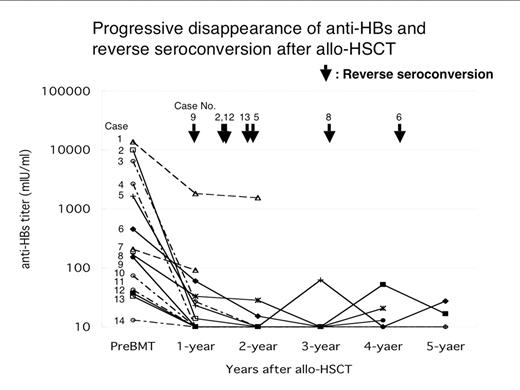Abstract
Development of anti-hepatitis B surface antigen antibody (anti-HBs) and clearance of hepatitis B virus (HBV) from serum usually indicate resolution of hepatitis in patients infected with HBV. However, most patients in whom HBV has been eliminated from the serum still have HBV DNA in the liver that is detectable by using polymerase chain reaction. Reactivation of this dormant HBV in the liver is known as reverse seroconversion (RS), which was reported to be a rare complication of hematopoietic stem cell transplantation (HSCT). However, the precise frequency of RS and results of long-term follow-up after RS have not yet been reported. We retrospectively studied HBV serological markers in fourteen patients with anti-HBs before allogeneic HSCT who were followed up for more than 1 year. Patients’ characteristics are as follows: median age at time of HSCT, 35 years (range, 22–52 years); M:F ratio, 9:5; hematological disorders: CML 5, ALL 4, MDS 3, SAA 2. No patients had prior history of vaccination or HBV-specific immunoglobulin usage. All donors were negative for hepatitis B surface antigen (HBsAg), and four donors were confirmed to be negative for anti-HBs. Only one case (case 1) had relapse of hematological malignancy during the follow-up period. RS is defined as disappearance of anti-HBs and appearance of HBsAg, HBV-DNA, and clinical hepatitis. The follow-up period varied from 15 to 92 months (median, 48 months). The actual risk of disappearance of anti-HBs and RS were calculated using the Kaplan-Meier method. Progressive decreases in anti-HBs titer were observed in all 14 cases. In 12 of the 14 cases, anti-HBs titer had decreased to under the protective value (<10.0 mIU/ml) at 10 to 38 months (median, 13 months) after HSCT. RS occurred in 7 cases at 12 to 51 months (median, 20 months) after HSCT. Onset and severity of hepatitis were not correlated. Although re-seroconversion occurred in 5 cases, the other 2 cases remained in HBV carrier status after resolution of transient hepatitis. In the other 5 cases, reactivation of HBV did not occurre even after disappearance of anti-HBs. In case with RS, disappearances of anti-HBs occurred up to 18 months before the occurrence of RS. The actual risks of disappearance of anti-HBs and RS were estimated to be 75.0% and 39.8% at 2 years and 100.0% and 70.0% at 5 years, respectively. Progressive disappearance of anti-HBs would be an inevitable phenomenon accompanied by progressive loss of recipient-derived B cells. In our study, RS after allo-HSCT was not such a rare event. RS hepatitis after allo-HSCT would be caused by reconstructed naive donor immunity after loss of recipient-derived immunity against HBV. In conclusion, RS is a late-onset complication with high frequency that can be predicted by careful monitoring of progressive disappearance of anti-HBs. Pre-transplant vaccination of the donor and/or vaccination for recipients depending on the decrease in anti-HBs titer would be prophylactic for reactivation of HBV.
Author notes
Corresponding author


